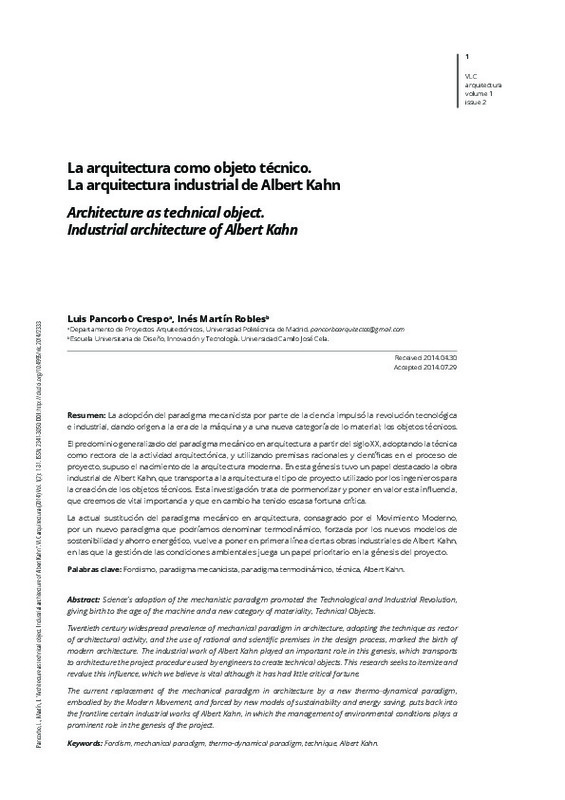JavaScript is disabled for your browser. Some features of this site may not work without it.
Buscar en RiuNet
Listar
Mi cuenta
Estadísticas
Ayuda RiuNet
Admin. UPV
Architecture as technical object. Industrial architecture of Albert Kahn
Mostrar el registro sencillo del ítem
Ficheros en el ítem
| dc.contributor.author | Pancorbo Crespo, Luis Guillermo
|
|
| dc.contributor.author | Martín Robles, Inés María
|
|
| dc.date.accessioned | 2014-11-20T11:18:50Z | |
| dc.date.available | 2014-11-20T11:18:50Z | |
| dc.date.issued | 2014-10-23 | |
| dc.identifier.issn | 2341-3050 | |
| dc.identifier.uri | http://hdl.handle.net/10251/44489 | |
| dc.description.abstract | [EN] Science’s adoption of the mechanistic paradigm promoted the Technological and Industrial Revolution, giving birth to the age of the machine and a new category of materiality, Technical Objects. Twentieth century widespread prevalence of mechanical paradigm in architecture, adopting the technique as rector of architectural activity, and the use of rational and scientific premises in the design process, marked the birth of modern architecture. The industrial work of Albert Kahn played an important role in this genesis, which transports to architecture the project procedure used by engineers to create technical objects. This research seeks to itemize and revalue this influence, which we believe is vital although it has had little critical fortune. The current replacement of the mechanical paradigm in architecture by a new thermo-dynamical paradigm, embodied by the Modern Movement, and forced by new models of sustainability and energy saving, puts back into the frontline certain industrial works of Albert Kahn, in which the management of environmental conditions plays a prominent role in the genesis of the project. | en_EN |
| dc.description.abstract | [ES] La adopción del paradigma mecanicista por parte de la ciencia impulsó la revolución tecnológica e industrial, dando origen a la era de la máquina y a una nueva categoría de lo material; los objetos técnicos. El predominio generalizado del paradigma mecánico en arquitectura a partir del siglo XX, adoptando la técnica como rectora de la actividad arquitectónica, y utilizando premisas racionales y científicas en el proceso de proyecto, supuso el nacimiento de la arquitectura moderna. En esta génesis tuvo un papel destacado la obra industrial de Albert Kahn, que transporta a la arquitectura el tipo de proyecto utilizado por los ingenieros para la creación de los objetos técnicos. Esta investigación trata de pormenorizar y poner en valor esta influencia, que creemos de vital importancia y que en cambio ha tenido escasa fortuna crítica. La actual sustitución del paradigma mecánico en arquitectura, consagrado por el Movimiento Moderno, por un nuevo paradigma que podríamos denominar termodinámico, forzada por los nuevos modelos de sostenibilidad y ahorro energético, vuelve a poner en primera línea ciertas obras industriales de Albert Kahn, en las que la gestión de las condiciones ambientales juega un papel prioritario en la génesis del proyecto. | es_ES |
| dc.language | Español | es_ES |
| dc.language | Inglés | en_EN |
| dc.publisher | Editorial Universitat Politècnica de València | |
| dc.relation.ispartof | VLC arquitectura. Research Journal | |
| dc.rights | Reconocimiento - No comercial (by-nc) | |
| dc.subject | Fordismo | es_ES |
| dc.subject | Paradigma mecanicista | es_ES |
| dc.subject | Paradigma termodinámico | es_ES |
| dc.subject | Técnica | es_ES |
| dc.subject | Albert Kahn | |
| dc.subject | Fordism | en_EN |
| dc.subject | Mechanical paradigm | en_EN |
| dc.subject | Thermo-dynamical paradigm | en_EN |
| dc.subject | Technique | en_EN |
| dc.title | Architecture as technical object. Industrial architecture of Albert Kahn | |
| dc.title.alternative | La arquitectura como objeto técnico. La arquitectura industrial de Albert Kahn | es_ES |
| dc.type | Artículo | |
| dc.date.updated | 2014-11-20T11:18:50Z | |
| dc.identifier.doi | 10.4995/vlc.2014.2333 | |
| dc.rights.accessRights | Abierto | |
| dc.description.bibliographicCitation | Pancorbo Crespo, LG.; Martín Robles, IM. (2014). Architecture as technical object. Industrial architecture of Albert Kahn. VLC arquitectura. Research Journal. 1(2):1-31. https://doi.org/10.4995/vlc.2014.2333 | es_ES |
| dc.description.accrualMethod | SWORD | es_ES |
| dc.relation.publisherversion | https://doi.org/10.4995/vlc.2014.2333 | |
| dc.description.upvformatpinicio | 1 | |
| dc.description.upvformatpfin | 31 | |
| dc.type.version | info:eu-repo/semantics/publishedVersion | |
| dc.description.volume | 1 | |
| dc.description.issue | 2 | |
| dc.identifier.eissn | 2341-2747 | |
| dc.description.references | Aicher, O. El mundo como proyecto. 1991. Barcelona: Gustavo Gili, 2007. | es_ES |
| dc.description.references | Aicher, O. Analógico y digital. Barcelona: Gustavo Gili, 2001 | es_ES |
| dc.description.references | Bucci, F. Albert Kahn, Architect of Ford. Princeton: Princeton Architectural Press, 2002. | es_ES |
| dc.description.references | Cody, J. W. Exporting American Architecture 1870-2000. Nueva York: Routledge, 2003. | es_ES |
| dc.description.references | Darley, G. La fábrica como arquitectura. Barcelona: Reverté, 2010 | es_ES |
| dc.description.references | Ellul, J. La edad de la técnica. Barcelona: Editorial Octaedro, 2003. | es_ES |
| dc.description.references | Kopp, A. Arquitectura y urbanismo soviéticos de los a-os veinte. Barcelona: Editorial Lumen, 1974 | es_ES |
| dc.description.references | Pareyson, L. Estética. Teoría de la formatividad. Madrid: Editorial Xorki, 2014. | es_ES |
| dc.description.references | Simondon, G. La individuación. Buenos Aires: Ediciones La Cebra y Editorial Cactus, 2009. | es_ES |
| dc.description.references | Smith, T. Making the modern. Industry, art and design in America. Chicago: The University of Chicago Press, 1993. | es_ES |
| dc.description.references | Spaeth, D. Mies van der Rohe. Barcelona: Gustavo Gili, 1986. | es_ES |








